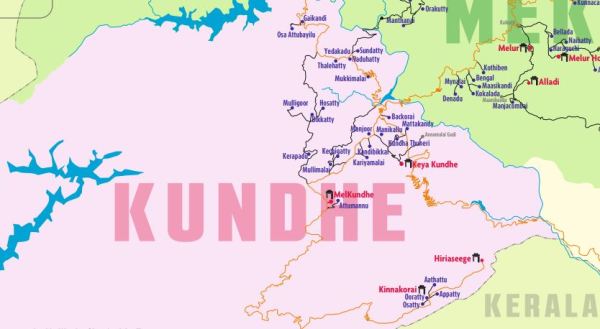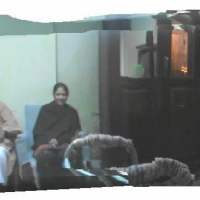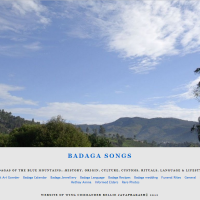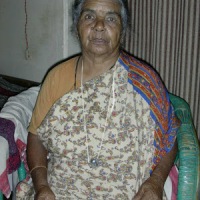Badaga Villages (Hattis)

[All photos are by Bellie Jayaprakash and copyrighted]
~~~~~~~~~~~~~~~~~~~~~~~~~~~~~~~~~~~~

Map Courtesy – Nellikolu Charitable Trust
~~~~~~~~~~~~~~~~~~~~~~~~
Badagas, generally, refer to their village or hamlet as ‘ HATTI ‘ spread around ‘Nakku Betta’ (the Nigiris). Nakku Betta literally means four (Nakku) Mountains (betta) though there are many hills around which the villages are located. It appears that initially when the Badagas established their hamlets, they took two very important factors into consideration. Being very environment conscious, they chose a) direction – always or to a very great extent facing the east [ ‘Hothu (sun) uttua (rising) pakka (side)’] and b) water souce – near a stream (halla) or spring (huttu neeru).Every hatti had a ‘suthugallu’ (sacred triangular shaped stone) at the base of a ‘bikka mara’ (tree) around which important meetings (Kootu) took place. For the most sacred of all Badaga festivals ‘Hethai Habba’ – always held on a monday (sovara), the collection of money (Hana kattodu) took place at the suthugallu in an elaborate ceremony on the preceding friday (belli). Let me write about Hethai Habba in a separate article.
The houses of each village were laid out in rows, each row facing the east. The houses had common walls (Gode mane) possibly as a measure of security. Every house had exactly the same configuration of Bayilu (entrance), Nadu mane (central-living/dining room ),Oge mane (inner room) where cooking also takes place (kitchen) with a large beskatti (basket) above the hearth where drying takes place, Pillay (bathroom) and Ereh (a separate room adjacent to the bayilu). Of course, there was an attic on top of beskatti( kitchen having a hearth) the entry to which is from the nadumane. Again, we will discuss about a typical badaga house separately.
A cluster of villages, which need not be close to each other, is called a ‘Seemae’.
Though, so much is written and spoken about Badagas, it is a matter of great regret and concern that still the “EXACT” number of Badaga hattis is not known. The total number varies from 300 to 400. Though Rao Bahadur H.B. Ari Gowder is known to have sent his collegue HAIKA MATHI [literaly meaning horse man] Joghee Gowder of Bygemandu, in 1940s and 1950s to all the villages to know about the problems of Badagas, unfortunately there are no written records traceable.
Prof. Paul Hockings may be one of the earliest to mention the number and names of the hattis in his books.
In a laudable effort, Mr. K.H.Madha Gowder who edited “NAKKU BETTA” magazine, had attempted to record all the hattis in one of its issues in late 1970s. I take this opportunity to list the villages as mentioned in ‘Nakku Betta’ hoping any omission/ incorrect mention will be brought to our notice so that the same can be included.
I have preferred to use the names as known to Badagas. For example, Jakkada for Jagathala or Manjidha for Manjithala or Pedduva for Pethala
I. ‘ Thodha Naadu Seemae ‘
(Supposed to be our “Dodda Ooru”. Also known as ‘Raja Padagiri Seemae’) The boundaries are from Solur to Kookkal Thore

Map Courtesy _ NelliKolu Trust
~~~~~~~~~~~~~~~~~~~~
1. Kada naadu 2. Kei Kauhatti 3. Baralatti 4. Kuntha Chappai {correct name given by KK Bellie} 5. Edu hatti 6. Kodu mudi 7. Thore hatti 8. Hanni Kore 9. Kavilorai 10. Kavaratti 11. Kara pillu 12. Kallatti 13. Soluru [Sholur] 14. Thalai male 15. Kengal 16. Bara mannu 17. Kengamudi [Kenguvamudi?]18. Ajjoor 19. Thatha benu 20. Kurumbedi 21. Alattane 22. Masickal 23. Davane 24. Mynale 25. Moregallu 26. Kendore 27. Beragallu 28. Ullupatti 29. Hosa hatti 30.Batta kore 31. Mavu kallu 32. Malli gore 33. Thatneri 34. Panju mora 35. Bikke Kandi 36. Bekkodu 37. Kokkulu 38. Bendatti 39. Osa hatti 40. Bana hatti 41. Honnadale 42. Thegili 43. Omeyaratti 44. Jakkalorai 45. Madithore 46. Thummanada 47. Kappachi 48. Muguttuva 49. Nelli Mandu 50. Karakkallu 51. Nanja nadu 52. Ode hatti 53. Melur 54. Akoni 55. Kada sole 56. Hosa hatti 57. Poose kunnur 58. Konagatti 59. Ebbanad [Ebbu nadu?] 60. Kagguchi 61. Kalingana hatti 62. Kookal 63. Seegola 64. Aalatti 65. Mel Kau hatti 66. Kambatti 67. Thummanatti 68. Billi kambai 69. Thooneri 70. Ooru malai 71. Mara kallu 72. Kuruthu kuli 73. Hullathi 74. Bikkatti 75. Athi kallu 76. Thattaneri (Repeat?) 77. Osa hatti (repeat?) 78. Motha kambe 79. Moragutti 80. Jeenatti 81. Bikke mora hatti 82. Uyilatti 83.Kookal Thore 84. Melatti 85. Nadu hatti 86.Thambatti 87. Asoganthorai
(What I have mentioned as repeat – may be there are two [H]Osa hattis ?)
Hello sir,
Iam S.Suresh(Kalhatty), i want to bring to yourattention that in the list of our hatties my hatty Masickal is missing, I dont know whether you misspelt it in Thothanad semae hatty number 22, If its misspelt please try to change it or if you have left it consider my humble request to add my hatty in it.. Also you have not mentioned Asoganthorai, add these two hatties in the list…- Thank you, Suresh – Wg Cdr JP
Badaga Villages with a cover of mist – seen from Akoni
II. Porangaadu Seemay
Also known as ” Aaila Baila Seeme ” ( Porangadu 19 Ooru ). From ‘Hubbathalai‘ to ‘Hulivare‘ constitute the boundaries

Map Courtesy – Nellikolu Trust
~~~~~~~~~~~~~
(Peria) Hubbathalai (Hatti)
Mel Bikkatti
Kil Bikkatti
II. Porangaadu Seemay
1. Thatha Nadu 2. Ora sole 3. Gundada 4. Pudiyangi 5. Marle Kambe 6. Batta Kore 7. Arakkambe 8. Mel Ane hatti 9. Kil Ane hatti 10. Dhimbatti 11. Kada kodu 12. Sippili kambe 13. Kanneri mookku 14. Ali Ooru [Hayoor?]15. Are hatti 16. Samil Dittu [Thanks to Bellie Sundaram Krishnamoorthy for giving the correct name] 17. Jakkalode 18. Kade kambatti 19. Kappatti 20. Kanneri 21. Nara giri 22. kunni hatti 23. Beraganni 24. Sundatti 25. Selakkore 26. Ker bettu 27. Betlada 28. Bendatti 29. Meedenu 30. Ker kambe 31. Lilli hatti 32. Bamudi 33. Neduguva 34. Bandime 35. Kodamale 36. Pedduva 37. Baiyangi 38. Kallatti 39. Hakkeru 40. Yeda palli 41. Eethore 42. Bettatti 43. Osatti 44. Katta bettu 45. Hubbathale Ooru 46.Honnore 47. Attave 48. Natta kallu 49. Kerbennu 50. Kathigatti 51. Eruppu kallu 52. Pudu mandu 53. Thotha mokke 54. Keraiyada 55. Jakkanare 56. Sakkatha 57. Kesalada 58. Aravenu 59. Thumbooru 60. Kallada 61. Bangalada 62. Thinni ooru 63. (H)Onnatti 64. Thooneri 65. Sulli goodu 66. Edukkore 67. Kengare 68. Hullathatti 69. Kottuvana hatti 70. Mel Odenu 71. Kil Odenu 72. Banni ooru 73. Bebbenu 74. Konavakore 75. Kakkul 76. Dhabba kambe 77. Thogalatti 78. Denadu 79. Ane ode 80. Thalore 81. Yettkallu 82. Odeyaru hatti 83. Mudia kambe 84. Selave 85. Kurukkathi 86. Kavilore 87. Selakore 88. Kottanalli 89. Thumbi male 90. Jakka kombe 91. Avvur 92. Bellada 93. Osatti (repeat?) 94. Embimora hatti 95. Bikkatti 96. Bagumudi 97. Dhodda mane hatti 98. Kagakkuthore 99. Koon sole 100. Jakkada 101.Odanatti 102.Bearatti 103. Malliore 104. Kakakore 105. Kil Bikkatti 106. Mel Bikkatti 107. Hubbathale Hatti 108. Kari mora 109. Kechigatti 110. Nadu hatti 111. Bettatti (repeat?) 112. Manjida ( recently added ) 113. Hayoor [Bellie Sundaram Krishnamoorthy feels this is same as 14.Ali Ooru – I fully agree. Hayoor or [H]Ali Ooru mean the same – Old Village] 114.Kinnakore, Heriasigay, Hosahatti, Ummattipadige Melur, Bikkatti
III. ‘ Mekku Nadu Seemae ‘
Also known as ‘ Asala Bisalagiri Seemay ‘ and (Meekunadu Seeme 9 Ooru).
Limits from Ketti to Keeyur

“Halattanai to which i belong to is the head hatti (oor) for keeyur haru hatti which includes denadu, mainalay, kothiben, masikandi, bengal and kokkalada inturn the keeyur comes under mekku nadu seemae (info from Dr.Bellukutty Sudhakar)”.Thanks to Dennadu Raman Bhojan (Bhoju) there is this interesting bit of news about DENAADU. Though it belongs to MEKKUNAADU SEEMAY, it forms a group of six villages called KIGOORU- KEEYUR (Kiloor). Denaadu people do not, usually, marry from the 33 + 6 [kigooru] villages of Mekkunaadu. Most of the marriages are from/to KUNDHAY SEEMAY, though of late, marriages have taken place from Villages belonging to PORANGAADU SEEMAY – like for example, Jakkadha (Jaghathala) of Aarooru (Jakkadha, Bearhatty, Karakorai, Mel Bikkatti, Kiya Bikkatti, Manjidha) group
Ketti (Mountain Railway track in the foreground)
1. Porore 2. Sogathore 3. Sakkalatti 4. Kethore 5. Denale 6. Dhoddani 7. Kil Odayaratti 8. Kodangatti 9. Kekkatti 10. Emakkatti 11. Ker kandi 12. Ellanalli 13.Hullada 14. Ketti Ooru 15. Achanakal 16. Halada 17. Theda hatti 18.[De hatti – removed as Prakash Chandran writes to say Theedatti is the correct name]19. Sora gundu 20. Kerada 21. Ken Kundhe 22. Kammandu 23. Mel Odayaratti 24. Thambatti 25. Adikaratti 26. Ane hatti 27. Mutti nadu 28. Oranai (Kattery) 29. Kattery 30. Nadu hatti 31.Thooratti 32. Kenduva 33. Koderi 34. Mel Koderi 35. Oor thittu 36. Allattane 37. Manja kambe 38. Denadu 39. Mynale 40.Kokkalada 41. Maasi kandi 42. Bengal 43. Kothi ben 44. Hulikkal 45. Panne bennu 46. Melur 47. Attu Bayilu 48. Porthi 49. Bembatti 50. Belitho 51. Ithalar 52. Pudugatti 53.Thodhale 54. Dhodda appukodu 55. Umar kandi 56. Angidi hatti 57. Byge mandu 58. Osatti 59. Kallakore 60. kariyalbe 61. Nunduva 62. Muduguva 63. Balakore 64. Meekeru 65. Manu hatti 65.Thangadu 66. Oranai 67. Kanneri 68. Mandhane 69. Godalatti 70. Bikol 71. Kasole 72. Mel Osatti 73. Kil Osatti 74. Haraguchi 75. Bellada 76. Nai hatti 77. Are hatti 78. Aadakore (Thulidale) 79. Bingichagallu(Bingisa Kallu) [thanks to Ganesan Lingan and Rajaram Ari ‘s (Yedakkadu)]
Nice to see Bingichagallu and Baigada were incorporate in the hattis list . …But Hosa attubayulu is still missing . Please add in the list.. Ganesan Lingan.

IV. ‘ Kundhe Seemae ‘
Also known as ‘ Eera Jilla Seeme ‘ [Kinnakorai Ooru removed from Kundhe seemae to Porangadu Seemae]

- Osatti 2. Bikkatti 3. Mel Kundhe 6. Attu Mannu 7. Mulli Male 8. Nadu hatti 9. Kechigatti 10. Kerabadu 11. Kariamale 12. Kandibikke 13. Manjooru 14. Mani Kallu 15. Kil Kundhe 16. Thooneri 17. Matta Kandi 18. Bakore 19. Mullegooru 20. Osa hatti 21. Bikkatti 22. Kunjanare 23. Gundinaali 24. Mukki Male 25. Gai kandi 26. Edakkadu Thale hatti 27. Edakkadu Nadu hatti 28. Sundatti 29. Baigada (added – based on Rajaram Ari’s (Yedakadu) input)
Added :
1. Kora Kundhe 2. Emarald (thanks to rajunandha
3. Hayoor (which is next to Kannerimukku in Kotagiri (thanks to mithun matha dharmaraj 4. Thorajada 5. Kombukorai (thanks to N Bellie 6. Thambatti added to ‘Thodha Naadu Seeme’ (thanks to Jagadeesh)
This is Ganesan Lingan from Porthy Village Mekku Nadu seeme.
“I just gone thru the Badagas website to know our hatties and seeme’s, I saw all the hattis and seems in one place and really enjoyed reading each and every hattis. I would say this is definitely Great effort! And really appreciable”.
I just wanted to you know that Emerald is not a badaga village( as per my knowledge) and fully occupied by other communities except one or two badgas having provisional stores and houses along with that, So I request you the remove the Emerald from our hatti list. And also I found Osa Attu Bayilu missing from Meeku nadu.
There are two Attu Bayilu one is Palliya (old) Attu bayliu and other one Osa attu Bayliu.
Also Bigada missing from Thodha nadu Seeme (not sure about seeme).This village spotted near Ithalar… This is a beautiful very tiny village located in center of the tea estates.
As elaborated in the page on Badaga Hattis [villages], still there seems to be no conclusive evidence about how the ancestors made the divisions [geographical and social] about their villages. Simply put, in ancient times, a few houses (among brothers and cousins) formed a HATTI and then a cluster of villages, though based not only on the geographical locations, formed a OORU. Obviously, all the people from the hattis forming the Ooru were/are considered as brothers and sisters – and hence no marriages among these hattis were considered. Then, many Oorus formed a a SEEMAY or NAADU.  And, FOUR Seemays or Naadus form NAKKU BETTA – representing the complete Badaga population in the Nilgiri hills. Though, only three Naadus /Seemays namely, Thodhanaadu, Mekkunaadu and Porangaadu have the Dhodda Betta peak as the apex and common point of these three seemays, KUNDHEY SEEMAY, at the southern eastern end, is very much a separate and important seemay. See the map. The confusion comes when we realise that some Thodha, Kotha and Kuruma villages/Oorus were also included into the broader periphery of Naadu/Seemay. The probable reasons for this inclusion could be the close association of Badagas with these tribes considered as the original inhabitants of the Nilgiris along with Badagas. Oorus forming Porangaadu Seemay ;Hubbathalai -[1.Dhodda Hubbathalai 2.Kunna Hubbathalai] Jakkadha – [1.Jakkadha 2.Kaarakorai 3.Bearatti 4.Mel Bikkatti 5.Kiya Bikkatti 6.Manjitha 7.Malligorai 8.Honnamudi 9.Odhanatti]Jakkanarai -[1.Jakkanarai Melkeri,2. J – Oorkeri, 3.J – Kiyakeri, 4. J – Thoria keri, 5.Thumboor ,6.Thinniyur, 7.Mudiakambai, 8.Bangalada, 9.Kallada, 10.Selavai, 11.Bettatti. 12.Naduhatti, 13.Arabettu, 14.Aravenu, 15.Aravenu Kettikeri] Thandhanaadu – [1.Thandhanaadu – Hayahatti, 2.T – Hosahatti, 3.Horasolai, 4.H- Honnodai, 5.Nattakkal, 6.Gundada, 7.Pudiyangi, 8.Maralakambai, 9.Meenikambai, 10.Battagorai (Gundada), 11.Arakambai, 12.Mel Anaihatti, 13.Kil Anaihatti, 14.Dhimbatti, 15.Kadakodu, 16.Thalorai, 17.Kannerimukku, 18.Haliyur, 19.Samilthittu, 20.Araihatti, 21.Ketchigatti, 22.Jakkalodai, 23.Kunnihittu, 24.Naragiri, 25.Kambatti, 26.Kappatti, 27.Kanneri, 28.Bergani, 29.Hullatti, 30.Jakkakambai, 31.Mel Oanay, 32.Kil Odanay, 33.Sundatti, 34.Kilinjimandhu, 35.Kavilorai, 36.Kotanalli, 37.Selakorai, 38.Bendatti, 39.Keirbetta -Hayatti 40. K- Kiyahatti, 41.K- Naduhatti, 42.K-Hosahatti, 43.Betalada]Meedhenu – [1.Meedhenu, 2.Kaikambai, 3.Battagorai, 4.Konavakkarai]Bandimay – [1.Bandimay]Niruguva -[1.Neduguva, 2.N – Hosatti, 3.Kurukutti]Peddhuva – [1.Peddhuva, 2.Kallatti, 3.Byangi, 4.Haddavalai, 5.Honnorai, 6.Thogalhatti, 7.Kattabettu, 8.Naduhatti, 9.Eethorai, 10.Bettahatti, 11.Yedapalli, 12.Hawkeru, 13.Gasugui, 14.Irruppukal, 15.Thothamokke, 16.Kerada, 17.Kerben, 18.Pudhumandu, 19.Hosahatti (Kattabettu), 20.Beben, 21.panneer]SakkadhaBebbaynuBaamudiKengarayDhenaaduKodamalaiDhoddamanay HattiKodanaadu Mandhu [Thodhas]Melay KokkalKiya KokkalKadinamala [Kurumas]Oorus under MekkunaaduKiya Ooru – HalattanayMelaga ooru – MelurThambattiKettiThangaaduAdhikarattiKatteryKollimalai (Kothas)Oorus under Thodhanaadu SeemayThooday GuiKadanaaduEbbanaaduSolurKagguchiHonnadhalaiKookkalThrichigadiPoosay CoonoorSolur Kokkal |
Oorus under Kundhey Seemay
[I have spoken to village elders at Kinnakorai and Hiriyaseegay during my recent visit to these villages and they insisit that Kinnakorai belongs to Prangaadu Seemay – Wg Cdr JP]
- Mele Kundhey
- Kiya Kundhey
- Hiriyaseegay
- Kinnakorai [?]
- Kundhey Kotagiri
The village names are given as pronounced by Badagas
[sources- ‘Badaga Samudhayam’ by Sivaji Raman, a well informed author and researcher from Jakkanaarai and ‘Akka Bakka’ by Prof. Frank Heidemann]
Discover more from Badagas of the Blue Mountains
Subscribe to get the latest posts to your email.














 Mookuthi
Mookuthi  Chinna
Chinna 






 ==
==


![Seemae [See'may] & Morae [Mo'ray] (relationship)](https://i0.wp.com/badaga.wordpress.com/files/2008/11/nakku-betta1.jpg?resize=200%2C200)









































How has the historical division of Badaga villages influenced the cultural practices and traditions within each hatti and Seemay?
LikeLike
Are there any ongoing efforts to document and preserve the history and boundaries of Badaga villages, hattis, and Seemays?
LikeLike
What role did Dhodda Betta peak play as a common point for Thodhanaadu, Mekkunaadu, and Porangaadu Seemays?
LikeLike
Are there specific cultural or traditional reasons for the naming conventions of Badaga hattis and Seemays?
LikeLike